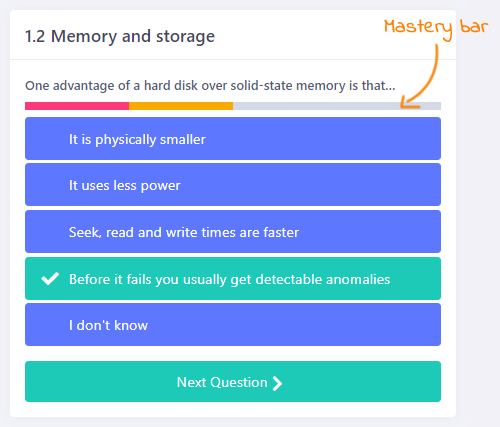Mastery
Each question in Quiz has a mastery bar that indicates how many times that question has been answered correctly in a row.
Grey: not seen before.
Red: answered incorrectly last time.
Orange: answered correctly once.
Yellow: answered correctly twice in a row.
Green: answered correctly three times in a row.
The goal for a student is to answer each question correctly three times in a row, turning the mastery bar green. However, a student never knows when a question is going to reappear due to the space, interleave and personalise algorithms that prioritise questions for students in different ways.
Mastered questions never completely disappear, they just have a lower priority. Questions answered incorrectly have a higher priority.
If a question is answered incorrectly at any time, the mastery bar returns to red. This may sound harsh, but it reflects the reality of examinations. It doesn't matter how many times a student answers a question correctly in class. If they answer incorrectly in an examination, the previous answers count for nothing!
Each course typically has ~500 to ~1000 Quiz questions depending on the size of the body of knowledge outlined in the course specification. This can make mastering some questions difficult as they may not be seen again for some time. To counter this, if the teacher enables student control of topic filters in the class settings, students can also choose individual topics and sub-topics to master. We recommend doing this before tests, mock exams and in revision time at the end of a course. With the teacher and Smart Revise in control at all other times to maximise the effect of the algorithms.

The research
Obtaining a high success rate is one of the ten Rosenshine principles. A success rate of around 80% has been found to be optimal, showing students are learning and also being challenged.
Subject matter is broken into blocks or units with predetermined objectives and specified outcomes. Students must demonstrate mastery on unit tests, typically 80%, before moving on to new material. Any students who do not achieve mastery are provided with extra support through a range of teaching strategies such as more intensive teaching, tutoring, peer-assisted learning, small group discussions, or additional homework. Students continue the cycle of studying and testing until the mastery criteria are met.
In practice mastery learning is challenging to implement because ideally students do not move onto new content until they have mastered what they have already learned. In addition, it may be more effective when students work collaboratively and take responsibility for supporting each other's progress.
Rosenshine, B. (2012) Principles of Instruction: Research-Based Strategies That All Teachers Should Know. American Educator, 36(1), p12-39.
https://educationendowmentfoundation.org.uk/education-evidence/teaching-learning-toolkit/mastery-learning